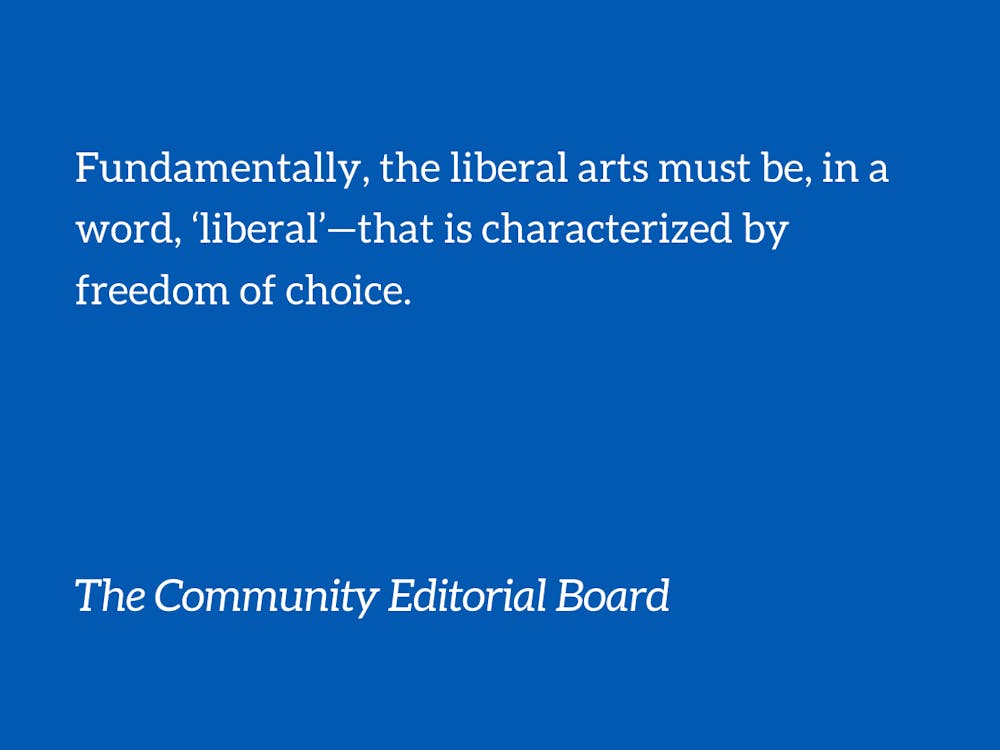To most, the utterance of the words “T-Rex” inspire the grandeur of a Jurassic predator. To Duke students, however, the term “T-Reqs” has a different meaning entirely. Duke prides itself on facilitating the growth of liberally-educated individuals while simultaneously honing professionally-applicable skills for post-graduation. As an institution that consistently toes the line between liberal arts college, D1 athletic machine, Wall Street water slide and R1 research powerhouse, Duke simply will not compromise on the ethos of the university.
While certainly a charming motto, the result of this Dr. Jekyll-esque mentality culminated in the Curriculum 2000 reforms and their associated abominations: the Trinity Graduation Requirements. In the broadest sense, Curriculum 2000 was Duke’s response to “extraordinary and extraordinarily rapid change” occurring at the turn of the millennium. Indeed, the main feature of these requirements was an array of six “modes of inquiry” complemented by an equally taxing five “areas of knowledge.”
This paternal matrix of requirements totals between twenty-four and twenty-six credits—the equivalent of six semesters of standard coursework, if taken individually. Granted, many courses are multi-coded, meaning that most students can satisfy their requirements much more quickly (13-15 courses), but to do so requires strategy and schemes.
The result of this labyrinth is inevitable: humanities-oriented students will often shy away from introductory chemistry or 200-level biology, and instead take the Duke-equivalent of ‘Rocks for Jocks’ (see Serena Kerrigan). Why shouldn’t they? Afterall, introductory courses in STEM are notorious for weeding-out non-specialists, essentially gate-keeping an entire discipline from the thousands of gifted students at Duke who would almost certainly benefit from the scientific mode of inquiry.
The reverse is also true. Despite being more accommodating at the introductory level, surveying a mid-level humanities course in a subject of interest can be a GPA torpedo if everyone else in the course has already mastered the writing style for the sub-discipline (we’re looking at you, philosophy). Many STEM majors, in turn, refrain from taking any ethics course that doesn’t have the word ‘biological, research or medical’ as a prefix. Why should we have to scheme our way to satisfy the Duke definition of the liberal arts?
Unfortunately, this problem has not been confined to the hypotheticals of this article. Students are well-known to take classes they have little interest in in order to satisfy as many T-Reqs as possible from a single course. In response, the Trinity Arts of Science Council made it impossible to count both an Arts, Literatures and Performances (ALP) code and a Civilization (CZ) code for the same course.
It’s at this point that the matrices turned schemes turned counter schemes become offensive to logic itself. How is it that a course in the history of the arts cannot give a student both ALP and CZ credit? The answer appears to be in the name of anti-scheming—not a regard for the contents of the many courses that satisfy such a definition.
Setting out clear objectives for what and how students learn is admirable; that said, the road to hell is often paved with good intentions. Put in terms of a different cliché, ‘a jack of all trades is the master of none.’
There is romance in the idea of the “Renaissance Scholar” who can speak on the politics of the day, deconstruct the anthropological and philosophical bases of those beliefs, as well as the biological foundations upon which they were first formed. Not all of us are romantics, however—or even if we are, sometimes preparing for life post-graduation takes precedence—our Pratt Stars certainly realize as much. Nevertheless, there must exist a balance between the convoluted maze that the T-Reqs have come to represent and a noble nudge in the direction of interdisciplinary exploration that students may need to attain a ‘liberal arts education.’
Fundamentally, the liberal arts must be, in a word, ‘liberal’—that is characterized by freedom of choice.
Brown University seems to have received that message when, after a review of an undergraduate group independent study project from circa 1968, the university adopted an “open curriculum,” with only two requirements: First, that students complete 30 course credits, and second, that they take two writing-intensive courses. Despite this flexibility, Brown remains one of the world’s renowned institutions for a liberal arts education. Over time, eleven colleges and universities, including Amherst College, Wesleyan University and Vassar College, have followed suit.
For those students who rightfully want to broaden the scope of their education without compromising their GPA in the process, the series of Freshman ‘89S’ seminars should be drastically expanded. Not only do faculty enjoy teaching these courses, which enable them to elaborate on an interdisciplinary aspect of what they do at Duke, but they offer invaluable lessons as to how different—even opposite—fields can complement each other.
Certainly, even under new regimes, some students will still elect to take short-cuts, but those who have that romantic streak would now be able to take a biology course without going up against a phalanx of pre-meds. As Duke’s Trinity Arts and Science Council discusses the future of Duke’s curricula, they should consider reforming Trinity’s requirements, and take care not to forget the word ‘liberal’ in the process of reforming the liberal arts.
The Community Editorial Board is independent from the editorial staff of The Chronicle. Their column usually runs on Tuesdays.
Get The Chronicle straight to your inbox
Signup for our weekly newsletter. Cancel at any time.

